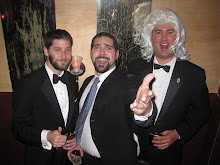In the summer of 2010, I missed several opportunities to secure a spot in one of Derek Brown's classes in the Columbia Room. The class was a tutorial on everything bitters. A wait-list was available which I joined. And in September, Derek revealed the dates for the fall/winter bitters classes (there are two sessions to fulfill the entire lesson). I eagerly signed up and prepared to absorb as much as possible about one of the most mysterious items in American taverns, even to many barkeeps themselves.
Bitters once occupied a realm in society that is somewhat recognizable to the contemporary imbiber: snake oils, tonics, curatives, et cetera. In other words, they supposedly supplied a remedy by which human beings could affect their "humors" and, by consequence, their constitution. An assertion, Derek noted, that has since been discredited.
But what about the bar?
Like the Archaeopteryx to rest of the dinosaurs, bitters sits perched on the bar shelf like some transitional fossil from the cretaceous epoch. Never truly concluded on whether it is a spirit or some kind of condiment, some bartenders pretend it's not even a part of their cache of ingredients. I guess some could say bitters became lost.

But as Bob Dylan once said: the times they are a-changin'. Clientele are becoming more aware of a whole market of bitters brands besides the ubiquitous Angostura. They are being exposed now to mixologists who specialize in different iterations of bitters. Among the more unconventional examples, successful flavors include tobacco, leather, cola, and cannabis. That’s right… cannabis.

Students took their seats to place-setting of raw materials. From the top left, down: bitter orange peel, anise, caraway, cinnamon. From the top right, down: gentian root, dandelion, quassia bark, wormwood. Together, Derek told us, these elements constituted the greatest commonality between the various bitters.
The class was a whirlwind of information for booze lovers. All the while, the two darling assistants, Katie Nelson and Adriana Salame-Aspiazu, fashioned the students a bourbon-based drink called the Seelbach:
The Seelbach
- 1 oz bourbon whiskey
- 1/2 oz curacao
- 7 dashes Angostura Aromatic Bitters
- 7 dashes Peychaud's Bitters
Shake with ice. Strain into a chilled champagne flute. Top with sparkling white wine. Garnish with a lemon twist. Enjoy.
A Manhattan cocktail without bitters is kind of like the Manhattan island without skyscrapers: flat. Derek demonstrated this feeling perfectly serving his class two Manhattans, one with and one without bitters. Any student could have distinguished the richness of the beverage by studying the color alone. The Manhattan with bitters possessed a robust amber pigment while the one without appeared pale and sickly (but still consumable... it is whiskey after all).
Amazingly, the drink sans the spice tasted neutered and absent of the savory flavor that makes the Manhattan sui generis. The point was made and the significance of bitters began to take root, so to speak.
Amazingly, the drink sans the spice tasted neutered and absent of the savory flavor that makes the Manhattan sui generis. The point was made and the significance of bitters began to take root, so to speak.
The final cocktail of the evening (at least as far as this bitters class was concerned) rested on a full 1 1/2 oz of Angostura Sour. While that amount was quite the declension from the typical amount of bitters used, I was captivated by the concept. The volume of the Angostura and the inclusion of a small egg white, among the other ingredients, demonstrated a pleasantly unique taste.

"Let's taste them all together," Derek concluded as he passed around each bottle in his menagerie of bitters. He encouraged everyone to dribble a few drops of the ink-like liquid onto their hands to try. Impressive as Derek is at crafting a drink, his incredible generosity and curiosity far outshines the talent or the attention to detail he so obviously possesses. He also has to be one of the tidiest bartenders I have ever met.

Sadly, the class was running close to its allotted time. Each bittering agent was added to vodka (a neutral grain spirit) for maceration. In two weeks, when we return to the Columbia Room, Derek will resume the final half of the lesson with home-made bitters. Look for Part II of this post in the weeks ahead.
I am really hoping the lesson will include a detailed unit on that cannabis bitters. Maybe, just maybe, if I wish hard enough…






No comments:
Post a Comment